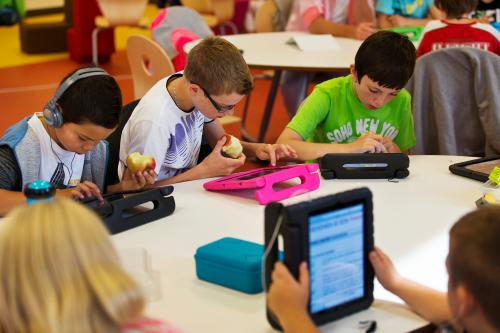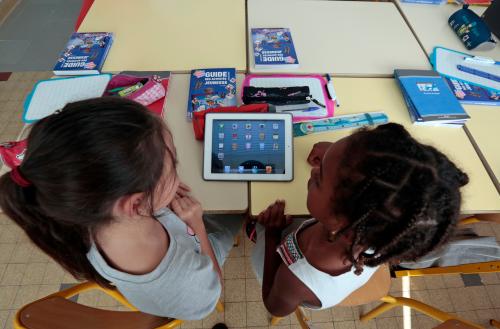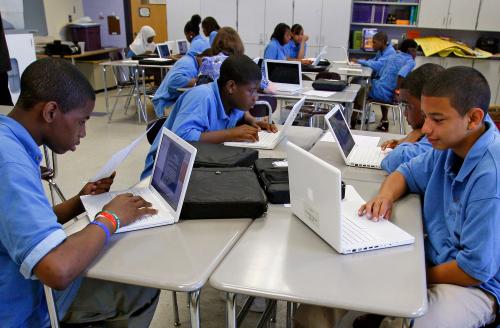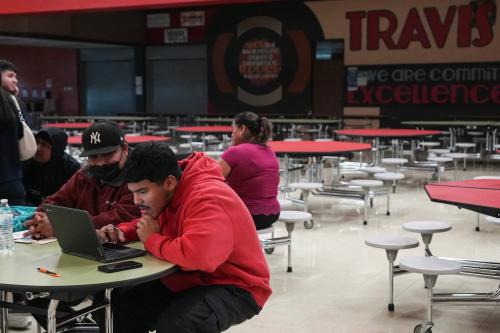Despite our best efforts, educational inequity persists across the country. This inequity currently takes a variety of forms including achievement, discipline, graduation, and opportunity gaps. Proponents and opponents of technology-enabled personalized learning alike believe that inequity remains a serious problem that needs to be solved sooner rather than later.
Many have interpreted inequity as an issue of unequal access to, among other things, educational technology—and expect that providing technology to all students will level the playing field. Recently, though, a growing number worry that the proliferation of educational technology in support of personalization may in fact exacerbate, rather than treat, the problem. The fact is that focusing on access when combining in-person learning with technology, known as blended learning, can lead to two possible outcomes: a world in which each student is supported in achieving their full potential, or a world in which technology-supported personalized learning primarily benefits those students who have the skills and experience needed to access and use it.
Perhaps how we conceptualize the problem of inequity itself is what will make the difference in which future world we eventually find ourselves in. I argue that “unequal access” is a mischaracterization of the issue, and instead propose that we focus on using technology as a formative tool to help educators address student inequalities (the “means”), rather than a summative one (the “end”).
Equity as an end
One perspective is that inequity itself is the problem to be solved. This approach can be thought of as being similar to curing a disease by treating symptoms. This framing looks at the data (usually achievement data), and operationalizes inequity as a gap in academic performance between groups of students characterized by their ethnicity, socioeconomic status, or first language.
In this paradigm, the incentive is to deploy technology in ways that are expected to “close achievement gaps.” The framing of inequity as an access issue fits best within this paradigm. This access to technology in the classroom may provide opportunities that reduce inequity—students who do not have these resources at home now have access to new learning experiences.
Yet, there are reasons to be skeptical of such an orientation to technology use. Increasing students’ access might enable learning to happen at each individual student’s pace, and in a location of their choice, but gaps will persist for those students who need additional support—whether with content, technology use, or managing their own learning—and the technology alone does not address these needs. In addition, some students will progress more slowly or not at all, and in a perspective focusing on access only, poor progress might be interpreted as “students having a slower individual pace” rather than a lack of adequate support.
For those who believe access alone is not enough, a focus on summative outcomes still leads to reducing inequity being characterized as raising certain groups’ average scores on a standardized test. Therefore, the best use of technology would be to provide the most support to the few students who are at the cusp of passing the test. Because their results can make all the difference in their group’s average, especially in smaller groups, the potential return on investment by focusing on these students is high in this paradigm. In other words, technology may be strategically targeted to achieve symptom improvements that may be fleeting for most of the students that policymakers are intent on helping.
Equity as a means
An alternative perspective is that inequity instead represents a symptom of an underlying need to be met. This subtle recharacterization of the issue leads to a noticeably different paradigm in the way we think about technology.
Here, inequity is characterized as differences in instructional need between individual students, and technology is used formatively to inform real teachers’ practice. From this perspective, educators’ focus shifts from test scores to students’ learning experiences, so that learning—rather than test scores—is incentivized. To be clear, test scores, standardized assessments, and indeed, accountability, are still important tools within this paradigm, but they are no longer the outcome of focus.
Personalized learning in this perspective need not include technology at all, although technology is the tool that can make many of these instructional approaches more precise and feasible. Instead, personalized learning could include frameworks like data-driven instructional decisionmaking and mastery-based progression to enable teachers to know where students are and how their needs can be met. Resource allocation would be based on student need, so that more resources would go to the students with greater needs, and fewer resources to those with smaller needs.
In this different paradigm, teachers would seek to understand where a student is in relation to their learning objectives, and would use a student’s past experiences to determine which of a range of instructional strategies (including flexible grouping, differentiation, formative assessment, etc.) would be most likely to help the student progress. A student would demonstrate mastery of more basic learning objectives before moving on to more challenging ones, rather than progressing at a predetermined, age- or cohort-based time.
When technology is used to diagnose needs and personalize learning experiences, students are supported in its use as well, because the goal of technology use here is to facilitate mastery of content and skills, not solely to raise test scores.
In this perspective, each student would be supported according to their needs, and no student would be forced to move on to new learning objectives, nor left to languish indefinitely at a certain level or trying to master a particular learning objective due to the impetus to take and pass a test at a certain age or grade level. Inequity, in effect, could be eliminated; students would perform at their greatest potential, benefiting from the unique learning experience they needed to thrive. There might still be variation in academic outcomes for students, but zip code would no longer be predictive of students’ test scores and other academic and life outcomes.
The Journey or the destination?
It may seem unbelievable that such a seemingly small shift in thinking about an issue could lead to such different results. The reality is that conceptualizing a problem indisputably shapes the solutions that are generated, and, in this case, the key to avoiding unintended consequences may lie almost entirely in how we define the core issue. Perhaps it is the journey, not the destination, that is important when we use personalized learning to combat educational inequity.






Commentary
Personalized learning and equity: The means or the end?
June 16, 2017